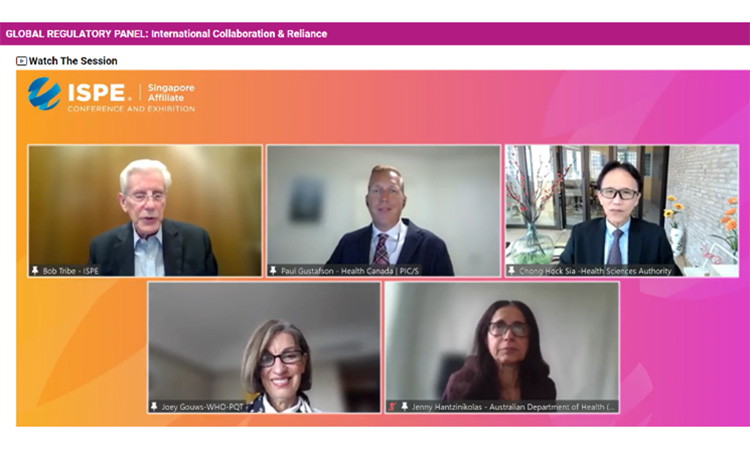International Collaboration and Reliance: Regulatory Panel Discussion at the 2022 ISPE Singapore Conference

At the ISPE Singapore Conference on 17 August 2022 during an online panel discussion, four international regulators discussed how the Covid-19 pandemic had taught regulators to look for alternative ways of conducting GMP inspections and also to rely more on each other to make determinations on the GMP status of manufacturers of medicines.
The regulators on the panel were:

Annex 1 Implementation:
The first question from the audience was referred to Paul Gustafson as it related to the implementation periods of 1 year for most of Annex 1 and 2 years for section 8.123 on lyophilizers (which Paul had mentioned in his presentation before the Panel Discussion). The questioner asked whether all PIC/S members would follow the same implementation periods or whether each country would make its own decision on timelines.
Paul indicated that not all PIC/S member authorities directly adopt PIC/S Guides. But PIC/S members do follow a harmonized approach in implementing PIC/S Guides, with some members having different strategies to facilitate such implementation into their existing GMP framework. This could result in some differing timelines for publication and implementation, particularly starting dates. He indicated that the 1-year and 2-year implementation periods were essentially transition periods before Annex 1 was enforced.
When asked about the likely date for the publication of Annex 1, Paul indicated that it would be towards the end of September (Annex 1 was published by PIC/S in early September 2022: PICS Annex 1).
Asked if WHO would adopt Annex 1 unchanged, Joey Gouws indicated that it was likely that WHO would make at least three small editorial changes before Annex 1 was adopted. These likely changes were still under discussion with WHO member states.
Sia Chong Hock indicated that HSA (Singapore) would adopt Annex 1 unchanged; during the first cycle of inspections, deficiencies against the new Annex 1 would be treated initially as observations or areas for improvement. Following the first inspection cycles, any deficiency against the new Annex 1 would be deemed a non-conformity.
Jenny Hantzinikolas said that TGA (Australia) would also adopt the new Annex 1 unchanged after a detailed gap analysis against the old Annex 1 requirements, and after consultation with key industry bodies. It was usual practice for TGA to prepare additional guidance/explanatory documents for industry and for TGA inspection staff to participate in training seminars to assist industry.
ICMRA’s Pilot Program for Collaborative Hybrid Inspections (ICMRA Pilot - Collaborative Hybrid Inspections):
Another audience question asked about the recent announcement by ICMRA (International Coalition of Medicines Regulatory Authorities: ICMRA) that it would commence a 12-month pilot program of collaborative hybrid inspections in the third quarter of 2022.
Jenny Hantzinikolas explained the regulatory authorities that would participate in the pilot program were EMA, US FDA, MHRA (UK), ANVISA (Brazil) and PMDA/MHLW (Japan), with the scope of the pilot limited to pre-approval and pre-licensing medicine inspections, but would not include surveillance medicine inspections.
The aim of the pilot was to gain information on how to prepare, execute and report a collaborative hybrid inspection. She said that the learnings from the pilot program could result in the scope of collaborative hybrid inspections being increased and other regulatory authorities invited to participate in an expanded program.
Mutual Reliance:
Paul Gustafson was asked about the extent of mutual reliance amongst PIC/S member, e.g., would US FDA rely on GMP inspections conducted by TGA in Australia or in a 3rd country such as India?
Paul indicated that in 2018, ICMRA introduced an Inspection Reliance Guideline which was adopted by PIC/S (PICS Inspection Reliance Guidance). He said because of today’s complex supply chains there is a need to rely on GMP inspections of other PIC/S members by sharing inspection reports. The benefits of cost savings for Inspectorates and for industry were substantial; Health Canada had conducted a “return on investment” study that clearly demonstrated such cost savings. He pointed out that the application of the PIC/S Inspection Reliance Guideline was voluntary for PIC/S members.
Sia Chong Hock was asked about the extent of mutual reliance amongst ASEAN GMP Inspectorates. He indicated that of the 10 ASEAN member countries (ASEAN Members), only 5 ASEAN Inspectorates (Singapore, Malaysia, Indonesia, Thailand & Philippines) were participating in the ASEAN MRA on GMP inspections (ASEAN MRA on GMP Inspections) which enabled the mutual reliance on GMP inspection reports, but this only applied to inspections of manufacturers of pharmaceutical products in finished dosage form, and not to biologicals and APIs. However, because the regulatory authorities of Singapore, Malaysia, Indonesia & Thailand were also members of PIC/S, these regulatory authorities could exchange information and rely on inspections of biological and API manufacturers.
He indicated that as India was not a member of PIC/S or ASEAN, Singapore HSA does not recognize inspections carried out by the GMP Inspectorates of India. However, if a PIC/S member had successfully conducted a GMP inspection in India, Singapore HSA would recognize the outcome of that inspection.
Giving account and significant weight to assessments performed by another regulatory authority or trusted institution in reaching its own decision.
Joey Gouws
Under this definition, a regulatory authority need not adopt in totality any decision reached by another regulatory authority, but they make their own decision.
She said that WHO member authorities rely quite extensively on work done by other “stringent regulatory authorities”. WHO performs desk-top assessments and shares the reports of these assessments with other regulatory authorities to help them make their decisions on the GMP status of manufacturers.
She indicated that the WHO published on its web site GMP inspection reports as “WHOPIRs” or “WHO Public Inspection Reports” (WHO Inspection Services) which were publicly available as redacted inspection reports. If a regulatory authority wanted a full inspection report, this would be provided after WHO had first sought permission from the manufacturer concerned.
She said that WHO relied extensively on the inspection reports of PIC/S member authorities and vice versa.
Dr Gouws added that WHO was the only regulatory authority to have performed inspections of Chinese manufacturers of Covid-19 vaccines during the pandemic. These were difficult inspections, mainly because of the need for inspectors to quarantine in China for 3 weeks before the start of each inspection. The outcomes of these inspections were shared extensively with MRA partners such as EMA and US FDA. For other regulatory authority requesting these inspection reports, the WHO would first seek permission from the manufacturer before providing the full inspection report to the regulatory authority. She said that redacted summaries of these inspection reports were posted on the WHO website.
Dr Gouws indicated that many of the Covid-19 vaccine manufacturers in India had also been inspected by WHO and a similar information sharing approach had been undertaken by WHO.
Paul Gustafson was asked whether PIC/S member authorities will rely on the inspection outcomes of the Inspectorates of countries such as China, India and Pakistan after they become members of PIC/S. He indicated that in 2021 the regulatory authority of China made a pre-accession application to PIC/S (PICS Pre-accession Applicants) which would involve a voluntary 2-year gap analysis which is monitored by PIC/S, with the aim of determining whether the China GMP inspectorate is ready to make a full application for membership. Once a full application is made, there would be a detailed assessment of the systems and procedure of the China GMP Inspectorate by a PIC/S team over a 6-year period which would help build relations and trust. This 8-year long robust process enables PIC/S members to rely on the outcome of GMP inspections conducted by the regulatory authority of China and other applicant authorities. The same approach would be in place for regulatory authorities of India and Pakistan, and any other regulatory authority that wished to become a member of PIC/S.
Sia Chong Hock was of the same view as Paul Gustafson and added that a PIC/S member authority always had the right to conduct its own inspection or a joint inspection in cases where this was justified.
Inspection Databases:
The panelists were asked about the various inspection databases that were available for Inspectorates and the public to obtain information on GMP inspections.
Joey Gouws indicated that “Public Inspection Reports” were posted on the WHO website and these can be accessed by regulatory authorities and the public. Although these are abbreviated (redacted) inspection reports, regulatory authorities can request full inspection reports if needed. Also, WHO publishes publicly available “Notice of Concerns” that identify and describe non-compliant manufacturers and products in a transparent manner (WHO Notice of Concern).
Paul Gustafson said that Health Canada has access to the EUDRA GMP (EUDRA GMP Database) and FDA COMSTAT (FDA COMSTAT) databases. He indicated that FDA had an excellent “FDA Data Dashboard” which was publicly accessible (FDA Data Dashboard). Also, Health Canada has a publicly accessible database on GMP inspections called “Canada DHPID” which covers all GMP inspections undertaken in Canada and overseas since 2012, which provides information such as inspection observations, inspection dates, company ratings, etc. (Canada DHPID).
The approach by TGA (Australia) and HSA (Singapore) were very similar. They both had access to the EUDRA GMP and FDA COMSTAT databases to assist with their GMP compliance determinations. They do not publish inspection reports or inspection observations, but they do publish on their respective websites lists of licensed manufacturers of medicines and the categories of products/activities a manufacturer is authorized to undertake. Both regulatory authorities shared inspection reports with PIC/S member authorities where requested.
New Technologies:
A questioner from the audience asked “how do different regulatory authorities share their findings on new technologies such as gene technology, cell therapy products, etc.”.
Paul Gustafson indicated that it was a simple matter of one PIC/S member authority making a request to another member authority for information on the product or process concerned.
He added that there was some exciting work currently underway by ICMRA covering a broader information sharing platform, including not only GMP inspection information but also drug submission information. A reflection paper would be published in the near future which would indicate the involvement of both PIC/S and ICH as a long-term project. Because of ICH’s involvement, industry bodies would also be involved in the development of this project.
Joey Gouws said that this initiative by ICMRA was extensive and would help facilitate more rapid regulatory decisions through a knowledge management tool developed by ICMRA.
Metrics on Duplicate Same-Scope Inspections:
Paul Gustafson was asked whether PIC/S kept metrics on duplicate same-scope inspections by PIC/S member authorities.
He indicated that PIC/S has kept some data on duplicate same-scope inspections but admitted that more work needed to be done in this area. Consequently, a PIC/S Working Group on Inspection Reliance had been created recently to help break down the barriers that prevented the implementation of inspection reliance.
He said that a new PIC/S Strategic Plan would be released in the near future which would include an objective of improving transparency in relation to inspection reliance.
Asked if ISPE could assist in any way, Paul said that PIC/S greatly appreciated the metrics on duplicate same-scope inspections and costs involved that ISPE had shared with PIC/S in the past. He said that it was important to keep the conversation going and to implement and promote inspection reliance, and break down the barriers that prevent its implementation. He said that he looks forward to ISPE’s continued support on the implementation of inspection reliance.








